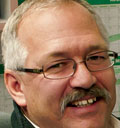There is a changing reality in many Mennonite churches today. Like other denominations, Mennonite congregations have long lost the gravitational pull they had in the early and mid-1900s, when community life revolved around church activities.
Many no longer have the burgeoning Sunday school classes of children that prompted churches to look at physical expansion in the 1960s and ’70s. Nominating committees everywhere face an uphill battle to fill committee positions in a world were busyness seems to be everyone’s mantra.
The recently released 2011 Statistics Canada report further indicates how the context of our Mennonite churches is changing. Brenda Suderman, Faith Page columnist for the Winnipeg Free Press, took a close look at the 2011 National Household Survey, and noted that, with more than 80 faith groups in Manitoba to pick from, roughly one-quarter of the population cited no religious affiliation. Across the country, “about 7.8 million Canadians have no religious affiliation, representing 23.5 percent of the population, up from 16.5 percent a decade earlier,” Suderman wrote in her May 18 report.
Changing contexts for churches
What does this changing context mean for Mennonite congregations? In his documentary film, One Size Fits All?: Exploring New and Evolving Forms of Church in Canada, church planter Joe Manafo visited churches that are adapting to their unique contexts to give viewers what he calls “a whiff of what God was/is up to on our shift as the local church in Canada.” In the film he says, “For too long the church has lazily been answering questions that no one is asking, focusing on managing and maintaining her structures, instead of facing into the empire in which she now finds herself.”
While a newly created task force is exploring whether Mennonite Church Canada and the area churches can continue to sustain their current programs, structures and strategies, individual congregations are already responding to their changing contexts. There is a growing awareness that current structures can’t continue serving the changing realities of their circumstances. Congregations are finding that structures and programs that served them well during the last century seem no longer sustainable—or don’t work—and may even stand in the way.
One church’s example
Erwin Warkentin, interim pastor at Whitewater Mennonite Church in Boissevain, Man., recognizes that his congregation has experienced significant change over its life. From its start in the 1920s, when Russian Mennonite immigrants settled in the area, to its heyday in the ’60s and ‘70s, when declining Mennonite congregations in the surrounding area joined it, congregational membership grew to 325, Sunday school attendance surged to 175, and a 70-voice youth choir filled the loft. Since then, Whitewater has seen a steady decline in its population, Warkentin says.
The church recognized that it needed to do something to adapt to the changing circumstances. “Our constitution calls for 125 positions, but we have only between 60 and 70 people attending regularly, and that includes children,” Warkentin notes, so in 2010 the church suspended its constitution and all programs except worship.
Congregants and staff look back on that as their wilderness experience. Since then, Whitewater has held monthly congregational meetings in an effort to discern an identity and a way forward.
“They don’t have deacons, a church ministerial, an education committee or a youth group,” Warkentin explains. “They have one Sunday school teacher for the three to 10 children, and they have a large and vibrant adult Sunday school class led by volunteers.”
Volunteers are called upon to help with various functions as needed. “If there are no volunteers, it doesn’t get done,” says Warkentin. “As the bulletin states, the ministers are the congregation.”
Many members of the congregation are heavily involved as volunteers in mental health services, the local food bank and the recycling program. “These are important areas we can call ministries,” Warkentin says. “We just need to recognize the ‘God connection’ and support our members as they engage in these ministries.”
Structures may be more lax, but the commitment to mission and outreach remains strong. Whitewater’s traditional annual spring mission event has continued, raising more than $8,000 for the church’s mission budget this year.
“When it comes time to identify the church programs we want to put back in the constitution, we want to do an inventory of where our ministries actually are, and from that discern what our church program is going to look like, rather than the other way around,” says Warkentin.
Focused beyond ‘the business’
Steve Drudge, lead pastor at Steinmann Mennonite Church, Baden, Ont., sees a similar change of direction in his church. “Back in the ’80s, we would ask how can we attract people to the church,” he says. “There was some parishioner swapping, but not a lot of church growth. Today, we are realizing it is not about attracting people to our church because church isn’t even on the radar in our culture. It is not about how to get people to our church, but how do we get the church to the people?”
More than a decade ago, Steinmann went through its own wilderness experience.
“We just couldn’t move ahead,” recalls member Gladys Bender. “We talked about wandering in the wilderness. We kept going in circles, but once we came up with a vision, we were able to move ahead.”
“What is happening in our community and do we want to be a part of it? Are we really organized in a way that is most effective? These were some of the questions we asked as we tried to fit our church programming with our vision,” says Bender, noting that the church has ended up with fewer committees and more coordinators who pull together ad hoc teams for specific short-term tasks. “It always comes back to, ‘Does it fit with our vision? Is it fitting with what God is doing in our community?’ ”
“We need to be continuously revisioning because things are in a constant state of flux, and the rate of change is faster,” says Drudge, pointing out that Steinmann no longer has a church council, but a vision focus team that begins every meeting with 30 to 40 minutes of visioning time. “We still get our business done and we do it in less time than when we focused on the business,” he says.
Dismantling previous structures
Calgary First Mennonite Church saw the need for change in the mid-1990s. People were leaving, especially young people who were not happy with the structure and leadership model at the time. With the help of interim pastor Ken Bechtel, the church was able to bring about change without alienating leadership. Over a period of three years, the previous structure was dismantled and a model that allows for greater lay leadership was adopted.
“I think it is working well and people are happy with the changes,” says Ed Kauffman, who has been pastoring the church for the past three years and who appreciates the flexibility the current structure affords. “We’ve tweaked it and we keep tweaking it here and there because things change, numbers change,” he says.
“We have dropped a few things, like the mission and service committee, because we couldn’t find people to serve and it wasn’t functioning very well,” Kauffman says. “But it doesn’t mean there aren’t still some of those activities going on. People are tapped on the shoulder for specific tasks as they are identified.”
As the number of youth in the church decreased while the number of children under 12 grew significantly, First Mennonite decided to shift from having a full-time youth pastor to hiring a half-time children’s worker. A lay person from the congregation now organizes Vacation Bible School and activities for children and youth, something members wanted but did not have the time or energy to take on themselves.
“I see this shifting again as these children become youth,” says Kauffman. “The focus will change. It’s going to have to flow organically. In this sense the current structure gives us more flexibility.”
What about membership?
One of the issues that is emerging in many congregations is the question of membership. “Many people in our congregations participate without being members, although their church constitutions often require membership for certain kinds of participation,” Voth acknowledges.
“How do we think about membership, commitment, accountability, discipleship?” he wonders. “They are wrestling with what membership means and with what should be the criteria for participation in leadership roles. Some churches are rewriting their constitutions and paring down their structures, opening up the criteria for participation of non-members.”
Henry Kliewer, leadership ministries director for MC Manitoba, also sees churches grappling with this question. “One of our larger congregations is broadening out the categories of membership
. . . in an attempt to deal with changing times, broadening out the sense of welcome at any stage in the faith journey.”
“Jesus didn’t care that much about membership,” says Kliewer. “However, Jesus cared an awful lot about the organic interaction between his disciples, the foot-washing business, communion, and remembering that Jesus is central. Our congregations need to model not so much the sense of wanting to be a family with boundaries to keep us all safe and close, but much more the sense of organic interaction and witness to Jesus that becomes our testimony to the world.”
The emerging church model
As churches opt for more fluid and flexible structures as they seek to be more missional, while trying to adapt to changing demographics and busy schedules, they often go through difficult and challenging wilderness times. Listening to the Holy Spirit and discerning a way into the future are often slow and difficult processes.
“The Holy Spirit is working through some of the loosening of the way we have done things,” Kliewer says. “We are to be the body of Christ. What are those elements that have crept in that are more of human making, and can come and go and shift with the context?”
Emerging churches may offer a model that is helpful. “In the emerging church, the faith community is predominantly relational,” explains Norm Voth, director of evangelism and service for MC Manitoba. “It is not the programs, or even the worship experience, that is drawing people into these churches, but relationships. The gatherings are fully participatory, often involving table fellowship, and can last two to three hours.”
“They are structuring themselves to be more involved in the local community,” he says. “People want a hands-on engagement. A lot of people are too busy for committee work because they don’t see that as being life-giving.”
“Healthy relationships remain a key component of effective Christian ministry and mission,” says Bechtel, an intentional interim pastor and consultant who has led many churches through significant changes. The age of modernity, he says, “may have promoted rationalism, dogmatism, nationalism and veneered religiosity, but postmodernity places a higher value on the experiential, spirituality, community, globalism, relativism and authenticity. In many senses, our post-Christendom, postmodern world is becoming more and more like that of the New Testament era.”
Warkentin, who brings a legal background to his work as interim pastor, says, “As a lawyer, I have done a lot of work with church constitutions in the past, and now with Whitewater we are trying to minimize the legality and maximize the flexibility, so that it will have the capability of responding to whatever the situation will require.”
“The whole business about constitutions, Roberts’ Rules of Order, being incorporated or not, was much more important following the decision of the government in World War I to impose a ‘temporary’ measure for raising revenue—called income tax,” he says. “As that temporary measure became more permanent, charitable organizations, including churches, needed to make sure they were properly constituted. As a result, over the last century churches have become much more corporately structured. I think it is the churches that have suffered as a result. The churches are much more tied up with what our constitutions and the rules of procedure say, rather than what does the Spirit say.”
“Probably the key feature I observe in churches that are moving forward is that, either consciously or intuitively, they are finding life-giving answers to the three core formation questions: ‘Who are we?’ ‘Who are our neighbours?’ and ‘What would God, therefore, have us do or be?’ ” says Bechtel. “If these become written vision or mission statements, those paper descriptions get revisited regularly, perhaps annually, inviting new hands-on initiatives.”
Earlier this year, Stuart Murray, author of The Naked Anabaptist, commented at the annual delegate sessions of MC Manitoba, “The Mennonite church community is quite healthy.”
Ken Warkentin, executive director of MC Manitoba, agrees. “Many of our congregations are quite healthy, but we will do well to think seriously about this in the next while, because there will come a time when our structures will be challenged to the point of breaking.”
These challenges, in turn, may lead more congregations to seek their own time in the wilderness. l
Evelyn Rempel Petkau is Canadian Mennonite’s Manitoba correspondent.







Leave a Reply
You must be logged in to post a comment.